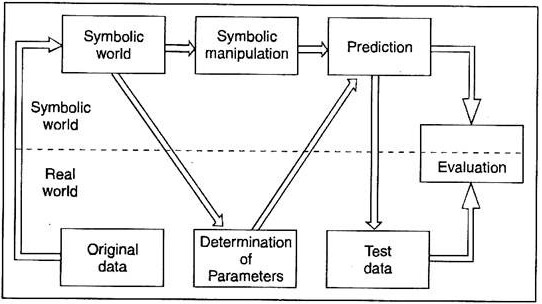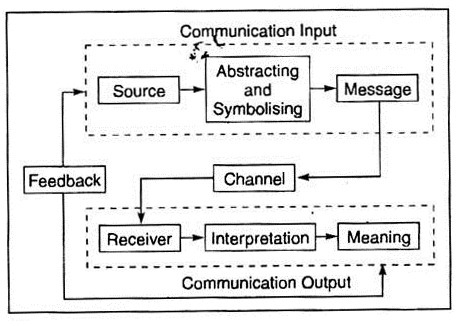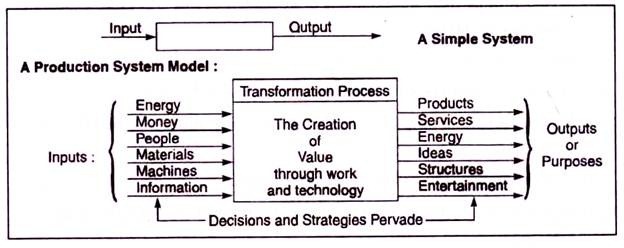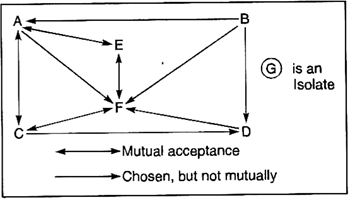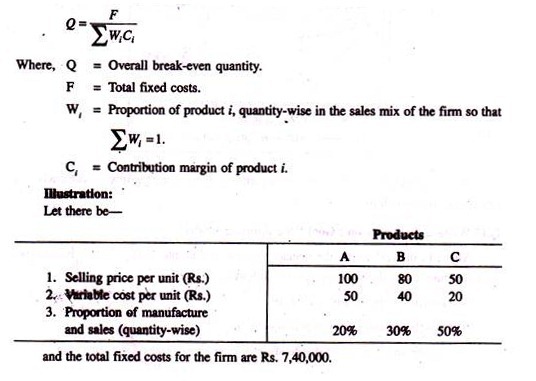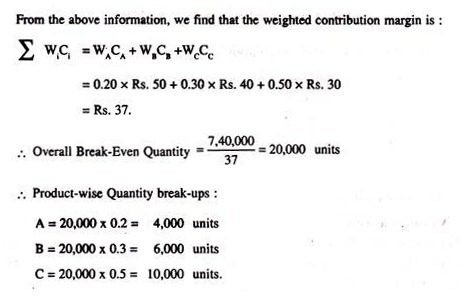Some of the frequently asked exam questions on quantitative models and strategic decisions are as follows:
Q.1. What is a ‘Model’ in business decisions and strategies?
Ans. The word ‘model’ is often used in conjunction with quantitative techniques for business decision making and for strategic choices. Almost all quantitative techniques can be classified as models.
Generally all business decision situations, although decision-contents greatly vary, have certain common factors like:
ADVERTISEMENTS:
(i) Alternative choices,
(ii) Possibility of various outcomes against a particular choice,
(iii) Occurrence of probabilities against an alternative, and
(iv) Inequality of the probabilities for each outcome.
ADVERTISEMENTS:
In such a situation, decision maker or the strategist has to determine the value or the utility with each unique action- outcome combination before he makes the final decision or strategy mostly in terms of pay-offs and costs.
A quantitative technique incorporates all these elements of business decision situations into a ‘model’ that is intended to maximise pay-offs and minimise costs.
So, a model is anything that in some way represents something else. It is an ‘abstraction’ or an ‘abstract’ representation of a real object, or system, or of a real world situation. A model, thus, abstracts the most important features of the situation.
Q.2. State the characteristics present in (or benefits derived from) a model?
ADVERTISEMENTS:
Ans. The specific reasons for using a model are:
1. A model in a decision situation provides a frame of reference to consider the decision-cum-strategy problem. A number of diverse considerations can be brought together in an organised fashion.
2. A model can suggest gaps in the manager’s information about the decision, even though the gaps are not immediately apparent. It can, consequently, suggest useful lines of inquiry.
3. A model brings out into the open the process of abstraction and decision-cum- strategy making. The process of abstraction is deliberate. An architect, for example, may decide that the number of exits from a building is not nearly as important for placement.
ADVERTISEMENTS:
4. A model, be it iconic, verbal, or mathematical, can be easily manipulated. For example, a mathematical model of an entire economy is capable of testing the effects of a variety of monetary and fiscal policies on economic outcomes without waiting for the actual economy to behave.
5. A model is always cost-effective and considered as the safest means to test alternative designs. The aircraft designers, for example, always test initial design alternatives on mock-ups to save materials and time and to remove the dangers of flying an untested aircraft.
6. Building a model allows the decision maker to simplify reality to the extent that he can grasp its salient characteristics, make his understanding of the situation rather more concrete, and focus his attention on the most important elements of the situation.
7. A model serves as a kind of filter, eliminating extraneous or confusing data, while, highlighting meaningful patterns.
ADVERTISEMENTS:
8. The primary value of a model lies in its simplicity relative to the real world.
Q.3. Identify the essential steps necessary in model building building and development.
Ans. The evaluation of a model for relative effectiveness refers to the test or criterion of a model in its ‘utility’ — that is, its demonstrated ability to make accurate predictions about the outcomes of a real decision. The standard for comparing models is utility i.e., successful prediction.
A model is neither true nor false but a standard. In developing or building a model, the following steps should be followed:
ADVERTISEMENTS:
1. Define the nature of the problem.
2. Select the features of the decision situation to be included in the model.
3. Solve the model (i.e., simulates actual decisions and predicts specific outcomes).
4. Test the model’s predictions against actual data (i.e., assess the accuracy of the model in predicting actual outcomes).
ADVERTISEMENTS:
5. Revise the model according to empirical or real-world outcomes. This involves repetition of steps 2 to 4 until a model is found that predicts as reliably as is necessary to solve the management problem.
ADVERTISEMENTS:
The diagram below presents the evaluation design, incorporating the place of symbolic approach, to decision models:
There is a need for crossing back and forth between the real world and the symbolic world and testing the symbolic model. It is essential that the facts from the real world continually confirm the symbolic model; otherwise, it will not provide practical answers to real problems.
Q.4. What are the limitations of decision models?
ADVERTISEMENTS:
Ans. The advent of computer and information technology has made a variety of ‘quantitative models’ to assist the decision makers. Models that used to take even months to solve by hand can now be solved in seconds by a high-speed computer.
The computer, through the storage of ‘programmed’ solutions, allows persons with only a minimum knowledge of the nature and assumptions of these models to employ them in assisting routine decisions.
Many computer experts however maintain that the computer and its stored programmes are dumb brutes. Without really judging the situation, some persons follow the instructions given to them. If the instructions are in error and represent faulty judgment, the results will also be wrong.
This phenomenon is called Garbage in—Garbage out. Thus, the use of sound managerial judgment in defining the basic nature of the decision problem is difficult to be substituted by simulation models.
The most basic limitation of quantitative models lies with the mathematical expressions. The assumptions incorporated into the derivation of a mathematical expression may not realistically portray occurrences in the real world. Quantitative models are not stronger than the strength of the assumptions underlying them.
Many managerial problems involve intangible or non-quantifiable factors. These factors greatly reduce the effectiveness of the decision models.
ADVERTISEMENTS:
Finally, even if input data is quantifiable and of the order necessary, it may not be economical in many cases to gather and process data needed for quantitative decision models.
Q,5. What could be the possible factors that influence a decision model?
Ans. The following factors present in management systems analysis can provide a good decision support in model building:
1. Problem and futurity
2. Acceptability and constraints
3. For whom
ADVERTISEMENTS:
4. Organisation levels involved
5. Importance and cost-benefit justification
6. Assumptions validity
7. Costs involved
8. Impact assessment
9. Reliability
ADVERTISEMENTS:
10. Presence of key parameters
Q.6. Illustrate the role of ‘feedback control’ in model building.
Ans. The feedback mechanism incorporated at the stages above can permit the design of an accurate model and thus, provides realistic and workable solutions to decide course of action needed.
The ‘feedback’ concept is a diagnostic tool or an on-going mechanism by which a decision maker collects and evaluates information concerning a model building.
It helps in constant refinement of data to match the requirements of a model as illustrated below:
The feedback mechanism incorporated at the stages above can permit the design of an accurate model and thus, provides realistic and workable solutions to decide course of action needed.
Q.7. Classify the various parts of the ‘Communication Process’ and incorporate them into a general model.
Ans. The diagram below presents a model of the communication process, showing the sequence in which the elements of communication occur.
This type of model can help us to consider and analyse communication situations.
In the communication model, ‘channel’ is important as it is the medium by which the communication is transmitted. For a channel, there are numerous choices and the choice depends on two parts: message and the person to receive it. Channels of communication could be a letter, telephone call, fax, telex, e-mail, broadcast via television or radio, or even a gesture.
Here, ‘Feedback’ is the process in which the receiver changes roles and becomes a ‘source’.
Q.8. List three main advantages of group decision making.
Ans. The main advantages of group decision making are:
1. Technical knowledge and expertise may be brought to bear on the decision;
2. Different backgrounds and perspectives allow the group to do a more rigorous job of sifting ideas; and
3. A decision group staffed with those who will implement a decision promotes identification with goals on a consensus basis.
Q.9. Distinguish between system and model.
Ans. A system is a set of relationships, interdependencies and interacting functions. A system is either natural (such as, solar system, eco-system, human nervous system, etc.) or man-made (such as, economic system, social system, political system, or an instrument/product system). A system is, thus, a real object or a real world situation.
But, we devise a model to capture the key elements and/or characteristics of a system. A model is not a real object or system but an abstraction of it in the form of a sketch, photograph, design, diagram or a visual item.
The toy car, the doll, and the buildings are all models of larger and real objects. Some models are ‘industrial’—to be used as test models such as an airplane in a wind tunnel. Industrial models are used to show what a product will look like before it is manufactured in great quantities. Educational models are used in teaching.
A model of the human heart can help students understand more about the human body. Similarly, a diagram or a chart of an actual institutional organisation is a model; a sketch of the law of supply and demand in economic theory is an economic model. With the advent of modern information technology computer simulation models are in great use in the world of business and commerce.
Q.10. Write a short note on ‘Systems Model’ as defined in business management literature.
Ans. In recent years, an increasingly useful framework for thinking about business organisation and managerial functions has been the systems model. For business purposes, a system is defined as a set of relationships, interdependencies and interacting functions which comprise a purposeful means for achieving an objective.
A spring-wound alarm clock exemplifies a simple and relatively closed, or self-contained system—a system that requires minimum interaction with external environment to function effectively.
A business organisation is considered an open system. It receives a multiple inputs from external environment—men, materials, machinery, money, etc.—in order to achieve its objectives. At the same time, it must return to its external environment certain outputs in order to justify its existence. It must create or generate something of value.
The overall business organisational system—which is a part of a larger social, economic, and political systems—is made up of a number of sub-systems. Though interdependent, the boundaries of many sub-systems are so clear that they function as distinct management units; for example, product research and development, quality control, etc.
Any change in one or more sub-systems as cited here, can have effect on the total system. The whole concept of system including these subsystems, when abstracted in a model, may be called a systems model.
For illustration, we may think of a production system model as follows:
Q.11. How Brainstorming and Gordon technique are useful in generating creative ideas that are necessary for choice of a particular strategic decision?
Ans. The following points suggest how brainstorming and gordon technique are useful in generating creative ideas that are necessary for choice of a particular strategic decision:
(i) Selection of personnel —A group from diverse background helps. There is a need to strike a balance of highly active and quiet members.
(ii) Mixed groups of men and women are usually more effective especially for consumer problems.
(iii) Relaxed and pleasant environment.
(iv) Group size should be within a limited number; say, 6 to 10.
(v) New members should be introduced and they should be briefed about the technique.
(vi) There should be a record of all ideas produced.
(vii) Sessions should better be held in the afternoon to avoid routine tasks being affected.
(viii) People from widely differing ranks within the organisation in the same session should better be avoided.
Q.12. What do you understand by ‘Synectics’, as a creativity technique for strategic decisions?
Ans. Synectics, a creativity technique, utilises a carefully selected creativity team and an experienced leader whose task it is to ‘structure the situations’ that force the participants to deviate from their usual modes of thinking. In order to arrive at creative solutions, various role-playing and fantasy exercises are used to invert, transpose, distort, or otherwise modify existing thought patterns.
In this sense, it is similar to brainstorming exercise. This technique is a novel method of breaking the rigid thought patterns and thus, improves an individual’s creativity. For strategic decisions concerning consumer industries, synectics is a novel technique.
Q.13. Write a short note on ‘Sociometric Analysis’ of a group’s strategic decision making process.
Ans. Sociometric analysis is a technique for analysing group processes by observing the frequency of communications between individuals, the content of the communications, and the sentiments of individuals about other group members. In short, it is a way of studying how group members prefer to interact.
Summation of group members’ preferences can identify four types of individuals:
1. Leaders—who accept the group’s purpose and provide the necessary direction.
2. Isolates—who do not get along with the rest of the group.
3. Deviates—who get along but do not accept all group norms.
4. Members—who typically identify with the group’s purpose and norms.
A sociogram model looks like:
The sociometric analysis can tell us about a lot about healthy or otherwise of intragroup relationships.
Q.14. Write a short note on Goal Programming Model.
Ans. In the real world, the managers pursue a multiple strategies; that is, multiple goal structure that includes, inter alia, the following:
(i) Growth in sales and market share,
(ii) Growth and stability of reported earnings, and
(iii) Growth and stability of dividends, etc.
This phenomenon of real-life situations, thus, requires a methodology for goal optimisation, The goal programming approach, a kind of mathematical programming, provides such methodology.
The goal programming methodology attempts to minimise the absolute deviations from the specific goals in order of the priority pattern established.
The goals at priority level of the first order are optimised first and thereafter, the goals of other priority levels, second or third, are considered. At a given priority level, the relative importance of two or more goals is reflected in the weights assigned to them.
The goal programming model is formulated in terms of three principal components:
(i) The objective function,
(ii) The economic constraints, and
(iii) The goal constraints.
The objective function seeks to minimise the weighted deviation from the target levels of various objectives in accordance with a priority pattern. The economic constraints, which are similar to the constraints found in a linear programming model, represent resource limitations emanating from the decision environment.
The goal constraints, defined as strict equalities, represent target levels of various goals that are pursued by the strategy maker/decision maker.
Q.15. Prepare a ‘Break-Even Analysis Model’ for a multiproduct firm and illustrate it with a numerical example.
Ans. In order to prepare a ‘B-E analysis model’ for a multiproduct firm, we have to first determine the proportions in which different products would be manufactured and sold.
The overall break-even volume of a multiproduct firm can be expressed by the model (in the form of a formula):
